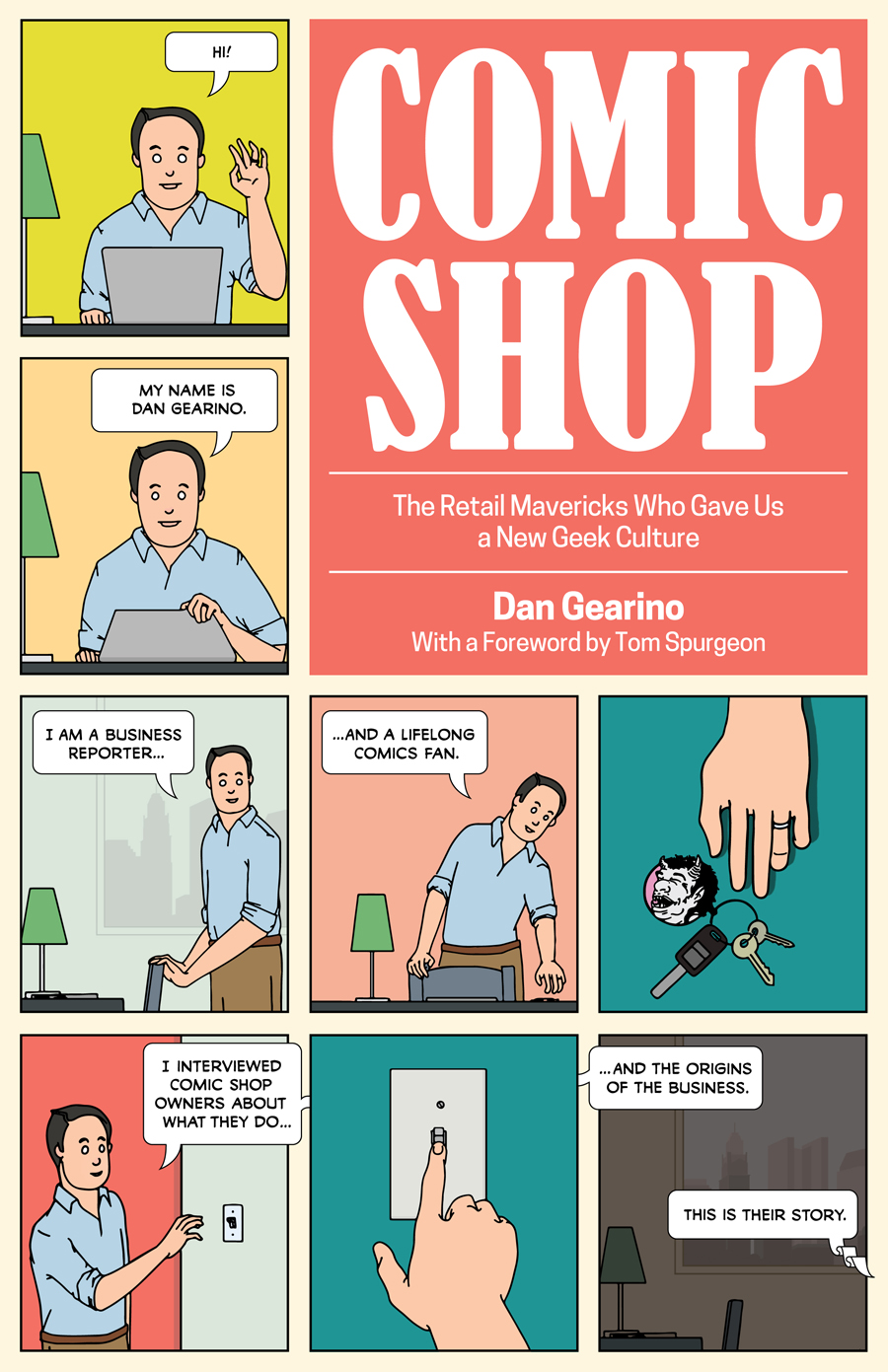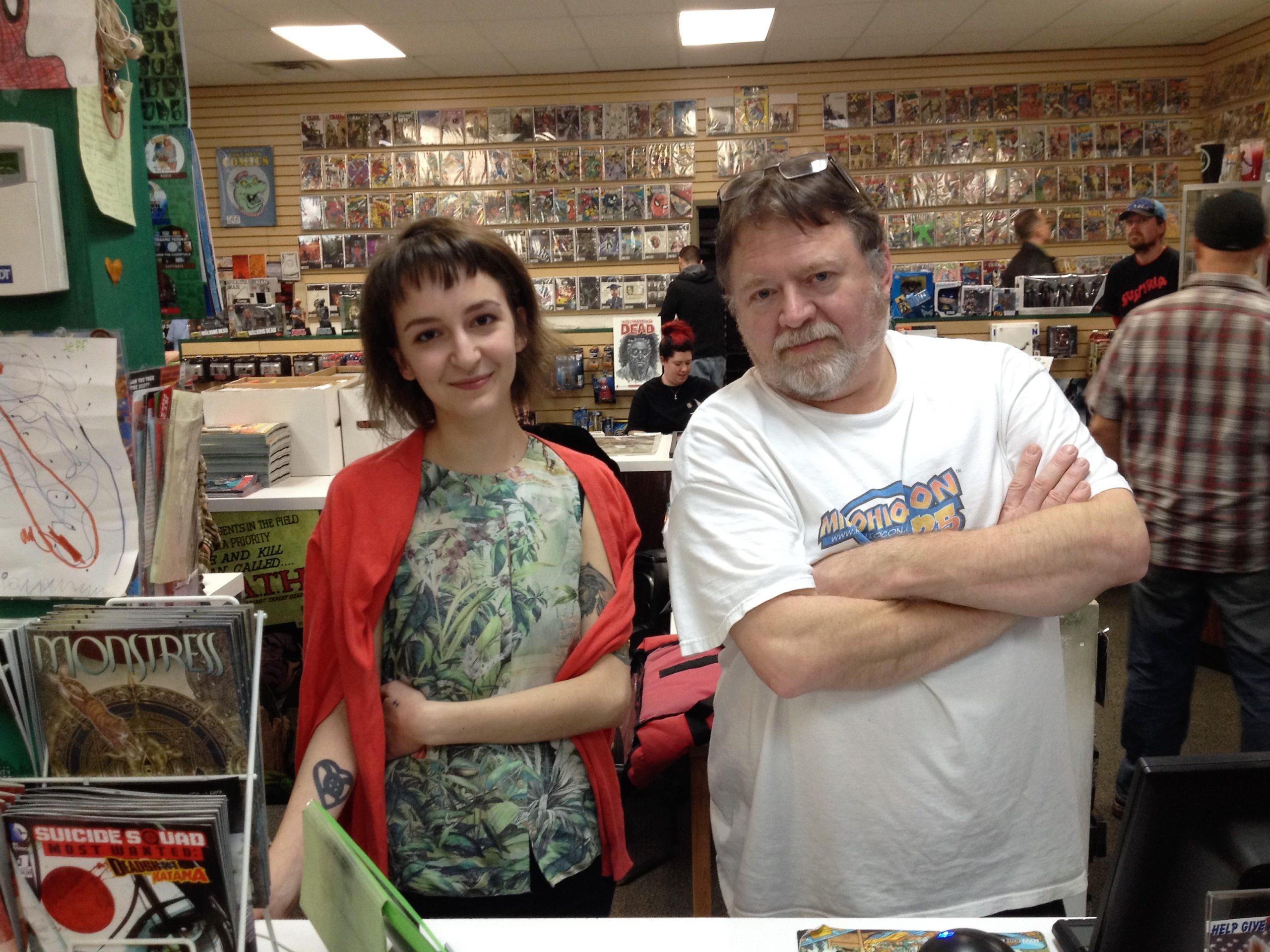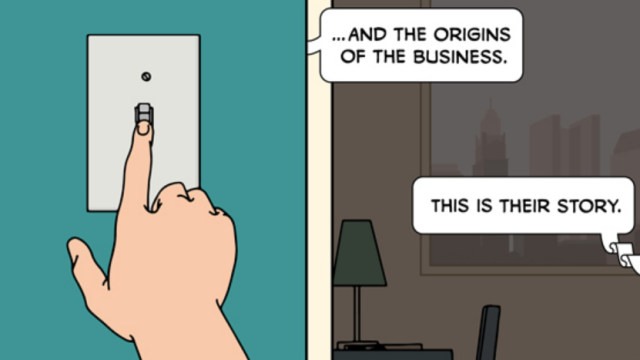Comic book shops can be great or awful places, depending on where you go. But they remain a key part of how many people experience the characters and creativity that the comics medium has to offer. A recently released book gives a fascinating glimpse at the challenges and pressures that store owners have to face in this hybrid retail business.
Detail from the cover art for Comic Shop. Image: Swallow Press
In his book Comic Shop: The Retail Mavericks Who Gave Us a New Geek Culture, journalist Dan Gearino explains how the business of selling comics has changed, and lays out the rise of the direct market in the mid-1960s. He also profiles some of the most highly-regarded shops in the United States, and makes the case that the modern pop culture era we’re living in wouldn’t exist without the rise of comic book stores.
Gearino was kind enough to answer some questions about the comic-book retail landscape, which you’ll find below, followed by excerpts from two chapters of Comic Shop.
Why do you think the stereotypical notion of the comics shop is negative and foreboding?
Dan Gearino: First, I’ll spell out the stereotype a little more: Messy displays, poor lighting, grouchy employees, a vague whiff of cat pee, and a general hostility to anyone who doesn’t obsess over superhero comics. This kind of place has a negative image because most people feel like they don’t belong. And, unfortunately, there are a lot of comic shops that fit this description to an uncomfortable extent. That said, just about every decent size metro area has comic shops that veer far from the stereotype. These are the kinds of stores that are expanding the audience for comics.
Is there anything you think a good comics shop does better than other entertainment retail businesses?
Gearino: Since new comics come out every week, and many customers shop on a near-weekly basis, comic shops get to know their regulars in a way that other businesses would envy. With this familiarity, shop owners and managers gain a real strength as taste-makers. If they find a new comic they like, they can turn around and recommend it to the customers who would like it, and build support for material that otherwise might get lost. Titles such as Scott Pilgrim and The Walking Dead are just two examples of word-of-mouth hits.
What do you think most people would be surprised to learn about the comic shop business model?
Gearino: The defining trait of the comic shop business model is non-returnability, which means that when a comic shop orders 100 copies of an issue of Superman, and sells 63 of them, the store is stuck with the surplus. Decades ago, the model made more sense because there was more of a market for back issues. Today, as just about every comic gets collected in book form and is available in digital, there isn’t much demand for recent back issues.
The result is that comics retailers will often live or die based on how closely their orders are to actual sales. This can go terribly wrong when a heavily hyped comic turns out to be a sales bust. The nonreturnable model is in contrast to the way most media retailers operate. A bookstore, for example, can return most of its unsold goods for a credit. Today, most of the best shops survive in spite of their model, not because of it.
When people discuss about the perils of the comics market, there’s often talk about cannibalisation of readership and the need to grow the audience. What do you think are the best examples of that in recent years?
Gearino: To understand the way comics audiences can be cannibalised, just look at how when I was a kid, there was one X-Men comic. It was a big deal when a spin-off title, The New Mutants, came out in the early ’80s. Today, there are too many X-Men-related titles for me to count, and I can’t imagine that many people buy every one. By adding a 12th X-Men title (I have no idea if there are that many right now), Marvel is trying to get more money from a super-devoted fan.
At the same time, there are plenty of comics that are succeeding at expanding the readership, and Marvel publishes a few of them. But the real growth in the comics market is taking place in the “young readers” section, which has grown like crazy. If you go to a third grade classroom and ask kids to name their favourite comics, the answers are more likely to be titles such as Cleopatra in Space, Zita the Spacegirl, or anything by Raina Telgemeier.
Could you compare the 1990s speculator boom-and-bust cycle to an event in another industry, in terms of impact and scope?
Gearino: The closest parallel would be any stock bubble. When people enter a market with the expectation that they will make big money quickly, this unleashes an unsustainable wave. The 1990s boom and bust very nearly killed the comics industry as we know it. It was the worst in what has been a boom-and-bust cycle in comics.
My local shop, the Laughing Ogre in Columbus, opened right in the heart of the 1990s bust, and it turned out to be good timing because they had no debt and an abundance of enthusiasm right as competitors were reeling. In contrast, there are too many stores and publishers that have gotten into comics near the peak of a boom, and that almost never ends well.
[Ed’s note: The following excerpts are adapted from chapters one and 10 of Comic Shop.]

On a Saturday, Gib Bickel sees a woman step into the children’s section of his shop. He approaches and gives his usual opener: “Canwehelpyoufindsomething?” The woman, with tattoos down both arms, is shopping for a graphic novel for her daughter. She has no idea what to get, although a book called Hero Cats has caught her eye. He points her toward something else, a favourite of his, Princeless.
“This girl, she’s a princess,” he says. “Her dad puts her there in a tower with all her sisters until a prince will rescue her, and there’s a dragon guarding her. And then she’s like, ‘Why am I going to wait around for some dumb boy?’ So she teams up with her dragon and they have adventures.” Sold.
Bickel has hand-sold more than one hundred copies of Princeless, a small press graphic novel that has become a cult hit and been followed by several sequels. This is what he does. It is what makes him happy. In 1994, he cofounded The Laughing Ogre, a comic shop that shows up on lists of the best in the country. Though he sold his ownership stake years ago, he still manages the shop and can be found there most days. He and the shop are essential parts of the Columbus, Ohio comics scene.
Laughing Ogre is one of about 3200 comic shops in the United States and Canada, mostly small businesses whose cultural significance far exceeds the footprint of their revenue. They are gathering places and tastemakers, having helped develop an audience for Teenage Mutant Ninja Turtles in the 1980s, Bone in the 1990s, and The Walking Dead in the 2000s. And yet, for all the value that comic shops provide to their communities and to the culture, their business model has a degree of difficulty that can resemble Murderworld, the deathtrap-filled amusement park from Marvel Comics.
Publishers sell most of their material to comic shops on a nonreturnable basis. By contrast, bookstores and other media retailers – some of which sell the same products as comic stores do – can return unsold goods. The result is that comic shops bear a disproportionately high level of risk when a would-be hit series turns out to be a dud. And there are plenty of duds.
The staff at Laughing Ogre, and at shops across the country, let me into their worlds for what turned out to be a tumultuous year, from the summer of 2015 to the summer of 2016. The two major comics publishers, Marvel and DC, did most of the damage, with many new series that did not catch on, relaunches of existing series that often failed to energise sales, and a months-long delay for one of the top-selling titles, Marvel’s Secret Wars.
The notable failures were almost all tied to periodical comics, single issues that are sold mainly to people who shop as a weekly habit. In other words, the leading publishers spent the year pissing off some of their most loyal customers and undermining their retailers. And yet, much of the sales slide was offset by growth of independent publishers and by small hits such as Princeless, big hits such as the sci-fi epic Saga, and many in between.
The Laughing Ogre is in a 1950s-era strip mall in a quiet neighbourhood about three miles north of Ohio State University. As you enter, the children’s section is to your left, guarded by a five-foot-high Phoney Bone, the scheming antihero from the best-selling Bone comics. The statue is one of a kind, loaned by Jeff Smith, the Columbus resident and Bone cartoonist. In the local comics scene, no name is bigger than Smith’s. The Scholastic editions of his work have sold millions of copies. If you haven’t heard of Bone, ask a kid about it.
Beyond the children’s section, the focal point is the left wall, along which recent comics and books are racked. This is a near-overwhelming array of products, with precisely 1008 slots, most of which are periodical comics. Each week about 150 new titles come in.
“People say, ‘You get paid to read comics,’ but I’m so busy,” Bickel says. “My job is never done.”
Most of the rest of the floor space is taken up by bookcases, holding thousands of titles. There are archival editions of classic newspaper strips, graphic novels, and graphic memoirs, among many others.
Laughing Ogre is now on its third owner, a businessman who lives in Virginia and also owns two shops there. Even Bickel was gone for a while. After the store was sold the first time, Bickel left for five years to sell cars. He came back in 2011, welcomed as a returning hero by employees and longtime customers.

Lauren McCallister and Gib Bickel at Laughing Ogre. Photo: Dan Gearino
“I think he has magical powers,” employee Lauren McCallister said of Bickel. “He’s like a master salesman, really. He has a way with every single person who comes through the door. It’s absolutely mind-boggling. Still to this day, after working with him for three years, I can’t tell you what kind of weird voodoo he’s working.”
The owners and managers of the best shops are a collection small enough that most of them know each other. They have seen some of the best in the business fail. They have failed themselves, or at least come close. Much of this is because of the unique risks of selling comics. Almost nothing about this model makes sense if you look at it purely in terms of profit and loss. You are much better off opening a Subway franchise. The best comic shops can mitigate the risk with smart ordering, loyal customers, and a few lucky breaks.
In the young readers’ section at The Laughing Ogre, filed under “T”, is an author who has upended a number of notions about the comics market of the 2010s. The store keeps a stockpile of copies of titles such as Smile, Sisters and Ghosts. Readers often refer to the author by just her first name, as if she’s a friend: Raina.
Raina Telgemeier grew up in the Bay Area and studied illustration at the School of Visual Arts in New York. Her early career looks like that of a lot of cartoonists, drawing and photocopying minicomics and selling them. Her big break was getting picked up by the Graphix imprint of Scholastic Corp. in the mid-2000s. Her first books were comics adaptations of The Baby-Sitters Club books by Ann M. Martin.
Then, in 2010, came Smile, an autobiographical story about losing her front teeth when she was in sixth grade and going through years of treatments at an already awkward age. Scholastic, with access to bookstores and school book fairs, helped put Telgemeier’s work into the right hands. She became the top-selling comics creator in the country.
Telgemeier’s success underscores two major changes in the market. First, she is someone whose work does not appear in periodical form before it gets published as a book. Second, her core audience is middle-grade readers, contributing to the diversification of comic shop customers.
Telgemeier has gained a huge following by selling work in a format that was almost completely absent from early comic shops. And her format’s growing popularity is one of the key forces that has changed the market.
At Comics & Comix, the pioneering Northern California chain, the first graphic books that could be described as hits were the Marvel Fireside series from Simon and Schuster, according to former employees. The series began in 1974 with Origins of Marvel Comics, a collection of reprints of origin stories of Marvel characters. Comics & Comix also had success with books from Starblaze Graphics, an imprint from the Donning Co. that began in 1978.
Marvel launched its graphic novel line in 1982 with The Death of Captain Marvel, by writer and artist Jim Starlin. This was different from the Fireside series because Marvel was producing new work that was designed to be read as a complete story in one volume. DC began its graphic novel line a year later.
By the mid-1990s, a new kind of comic shop was emerging in which books were out front and displayed much like in a bookstore. One of trendsetters was Rory Root, co-owner of Comic Relief in Berkeley. Root and business partner Michael Patchen opened their store in 1987 on Telegraph Avenue. For the first few years, it looked like much like a typical comic shop. The walls had racks for new comics, and much of the floor space was taken up by tables with boxes of back issues. Over the years, the store made changes to better emphasise books.
Comic Relief became one of the most influential stores of its era, and Root, who died in 2008 at age 50, was a leader among retailers. While many retailers give Root credit for having one of the first bookcentric shops, there were several others – such as Joel Pollack of Big Planet Comics in Washington, DC – who had similar ideas.
The trend line has continued, with book sales rising each year and taking up a larger share of comic shop sales. Shop owners say that most people new to comics are looking at them in book form, not as periodicals.
Mark Waid, a prolific comics writer with recent runs on All-New Avengers and Archie, and co-owner of Aw Yeah Comics in Muncie, Indiana, from 2013 to 2016, said, “[The shift from monthly comics to trade paperbacks] is better money for everyone in the long run and a better format. But it’s the changeover that is dangerous. That’s the part that could kill us, because all comic book stores still depend on that Wednesday cycle.”
One hazard is that the book business is much larger and more competitive than that of periodical comics. To illustrate this, let’s go back to Laughing Ogre, where Telgemeier’s Ghosts sells for the cover price, $10.99. A customer can get the same book from Amazon for $6.55, a 40 per cent discount. And the Columbus library system has 531 copies in circulation.
Despite this, Laughing Ogre sells many copies of the book. But the store’s larger opportunity is to serve customers who have become comics fans because of Telgemeier. If even one-tenth of her fans become steady comics readers, that is a large number. Lauren McCallister looks ahead to when readers raised on Telgemeier will be old enough to read autobiographical comics for adults. Those are the kinds of comics McCallister writes and draws when she is not at the store, and she can see a day when there is a huge audience that has been steeped in the medium.

Comments
One response to “A Snapshot Of How Comic Book Shops And Fandom Keep Changing Each Other”
I used to be a regular (every week) at Daily Planet is Brisbane but after more that 20 years (closer to 30) they had a couple ownership changes and problems with stock and lost me as a customer (along with a lot of others I’d imagine). Really sad because for decades the store was exactly like the one described in the article – staff knew the regulars and could make good recommendations for newbies and veteran fans alike.
It’s a sad reality that online is killing the comic book store, and the super-fast transition from serial to trades really doesn’t help. If you’re planning on keeping the book then it’s much easier and neater to put a trade on the shelf than figure out how to store 10 standard comic issues. And they’re available so quickly it’s not even like you have to wait long.
Not to forget the horrendous prices now. Hard to sustain a big pull list when the comics are typically $5 and up. All of which has got to be hard on shops fighting to pay rising rent and electricity costs.